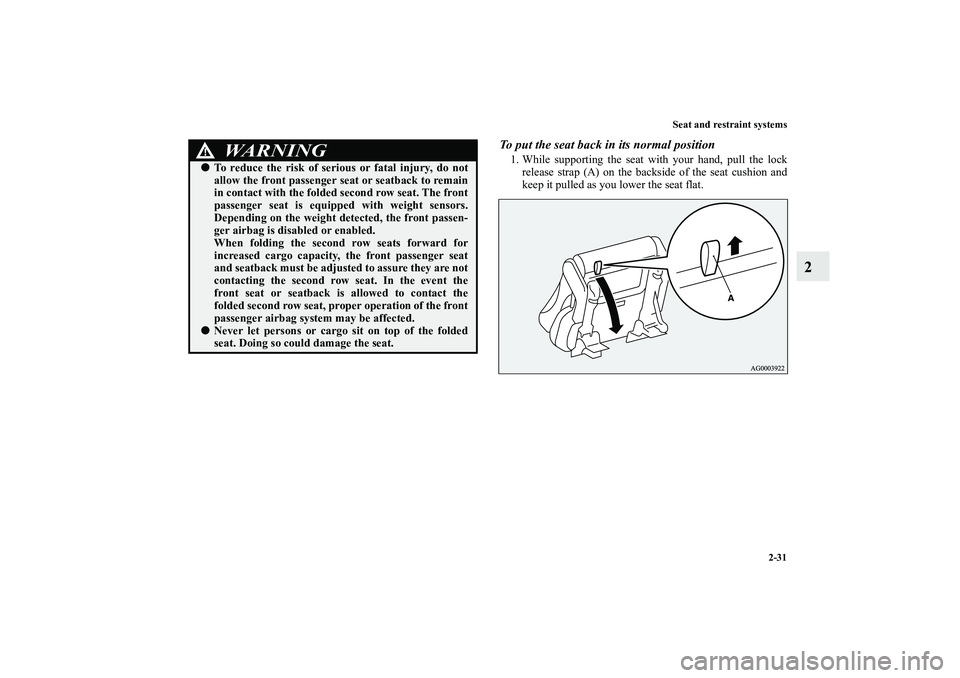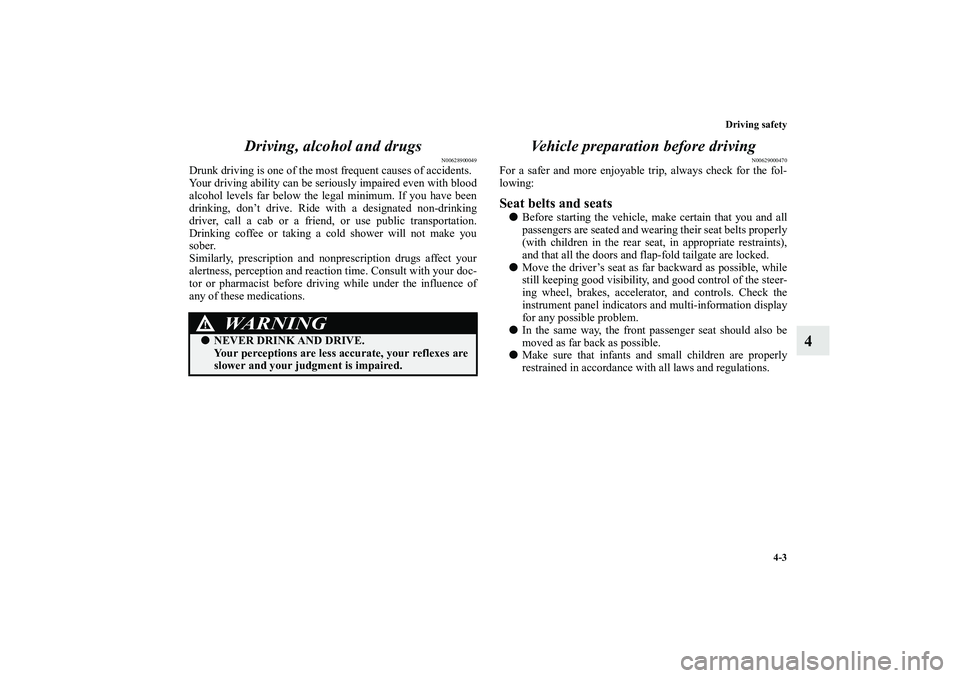Page 53 of 714

2-28 Seat and restraint systems
2Making a cargo area
N00405500091
NOTE�
When the seatback of a front seat is reclined, return it to
the upright position before driving.
WA R N I N G
!�
Never adjust the seats to make a cargo area when
the vehicle is in motion or on a slope. The seats could
move more than necessary or move suddenly and
cause a serious accident.
�
After folding up a seat or returning a seat back to its
normal position, make sure that the seat is firmly
secured. If the seat is not secured, it could move and
cause a serious accident.
�
Do not allow anyone to ride in the cargo area while
the vehicle is in motion. People who are not properly
seated and restrained can be seriously injured or
killed in an accident.
�
The front passenger seat is equipped with weight
sensors. Depending on the weight detected, the front
passenger airbag is disabled or enabled. When fold-
ing the second row seats forward for increased cargo
capacity, the front passenger seat and seat back
must be adjusted to assure they are not contacting
the second row seat. In the event the front seat or
seatback is allowed to contact the folded second row
seat, proper operation of the front passenger airbag
system may be affected.
CAUTION
!�
In the cargo area, do not load the luggage higher
than the top of the seats and make sure that the lug-
gage is firmly secured. Restricted rear vision or fly-
ing objects entering the passenger compartment
during sudden braking could result in a serious acci-
dent.
�
Seats should always be folded up and put back into
the normal position by an adult. Seat adjustments
by a child could lead to an unexpected accident.
�
When adjusting the seats, be careful not to catch
your hand or leg. Personal injury could result.
BK0115300US.book 28 ページ 2009年7月16日 木曜日 午前9時13分
Page 54 of 714
Seat and restraint systems
2-29
2
Folding the second row seats
N00405700107
The second row seat can be folded to create an additional cargo
area or to permit access to the third row seat on vehicles with a
third row seat.NOTE�
You can separately fold the right and left side of the sec-
ond row seat.
�
When folding down the seatback, the seat belt buckles can
be stowed in the slits on the seat to avoid leaving marks on
the seat.
“Storing the second row and third row seat belts” on page
2-44.
To fold up the seat1. Lower the head restraints to the lowest position.
Refer to “Head restraints” on page 2-25.2. Operate the lever (A) or lock release strap (B) on the sec-
ond row seats to fold down the seatbacks.
Operating the leverOperating the lock release strap
BK0115300US.book 29 ページ 2009年7月16日 木曜日 午前9時13分
Page 56 of 714

Seat and restraint systems
2-31
2
To put the seat back in its normal position1. While supporting the seat with your hand, pull the lock
release strap (A) on the backside of the seat cushion and
keep it pulled as you lower the seat flat.
�
To reduce the risk of serious or fatal injury, do not
allow the front passenger seat or seatback to remain
in contact with the folded second row seat. The front
passenger seat is equipped with weight sensors.
Depending on the weight detected, the front passen-
ger airbag is disabled or enabled.
When folding the second row seats forward for
increased cargo capacity, the front passenger seat
and seatback must be adjusted to assure they are not
contacting the second row seat. In the event the
front seat or seatback is allowed to contact the
folded second row seat, proper operation of the front
passenger airbag system may be affected.
�
Never let persons or cargo sit on top of the folded
seat. Doing so could damage the seat.WA R N I N G
!
BK0115300US.book 31 ページ 2009年7月16日 木曜日 午前9時13分
Page 57 of 714
2-32 Seat and restraint systems
2
2. Push down on the entire seat until it locks into place with
a click.NOTE�
You can load luggage with the seatback folded down.
CAUTION
!�
For vehicles equipped with a third row seat, be care-
ful not to catch the feet of any passengers sitting in
the third row seat, when returning the second row
seats to their original position.
BK0115300US.book 32 ページ 2009年7月16日 木曜日 午前9時13分
Page 408 of 714

Driving safety
4-3
4 Driving, alcohol and drugs
N00628900049
Drunk driving is one of the most frequent causes of accidents.
Your driving ability can be seriously impaired even with blood
alcohol levels far below the legal minimum. If you have been
drinking, don’t drive. Ride with a designated non-drinking
driver, call a cab or a friend, or use public transportation.
Drinking coffee or taking a cold shower will not make you
sober.
Similarly, prescription and nonprescription drugs affect your
alertness, perception and reaction time. Consult with your doc-
tor or pharmacist before driving while under the influence of
any of these medications.
Vehicle preparation before driving
N00629000470
For a safer and more enjoyable trip, always check for the fol-
lowing:Seat belts and seats�
Before starting the vehicle, make certain that you and all
passengers are seated and wearing their seat belts properly
(with children in the rear seat, in appropriate restraints),
and that all the doors and flap-fold tailgate are locked.
�
Move the driver’s seat as far backward as possible, while
still keeping good visibility, and good control of the steer-
ing wheel, brakes, accelerator, and controls. Check the
instrument panel indicators and multi-information display
for any possible problem.
�
In the same way, the front passenger seat should also be
moved as far back as possible.
�
Make sure that infants and small children are properly
restrained in accordance with all laws and regulations.
WA R N I N G
!�
NEVER DRINK AND DRIVE.
Your perceptions are less accurate, your reflexes are
slower and your judgment is impaired.
BK0115300US.book 3 ページ 2009年7月16日 木曜日 午前9時13分